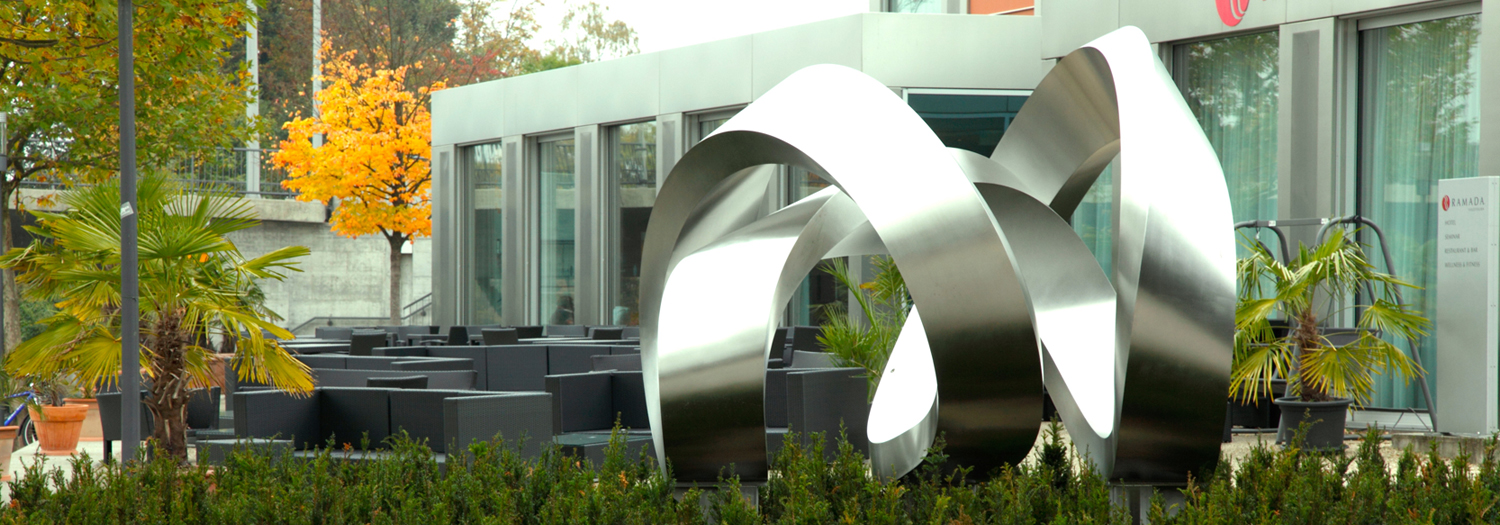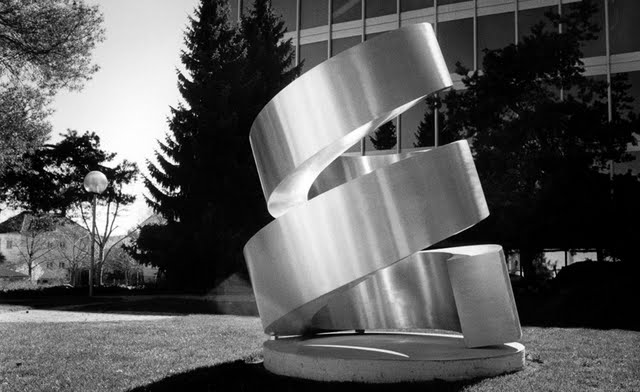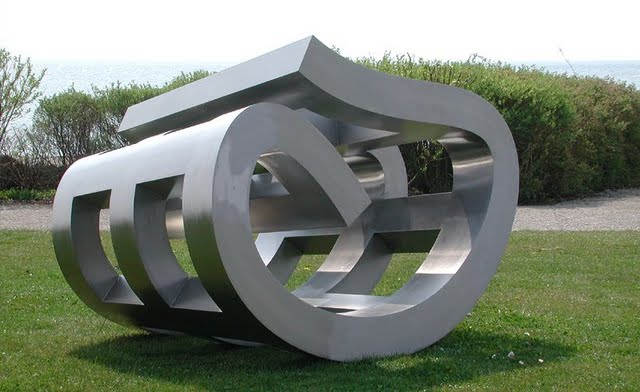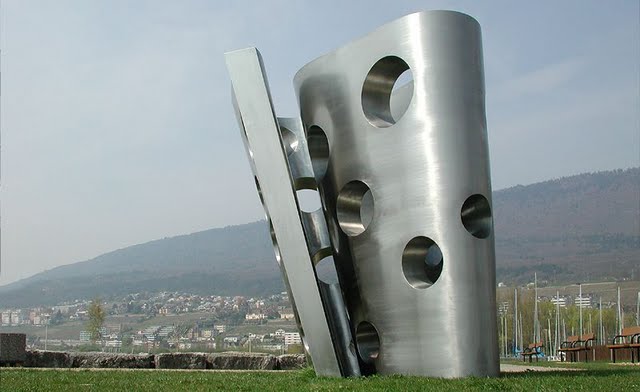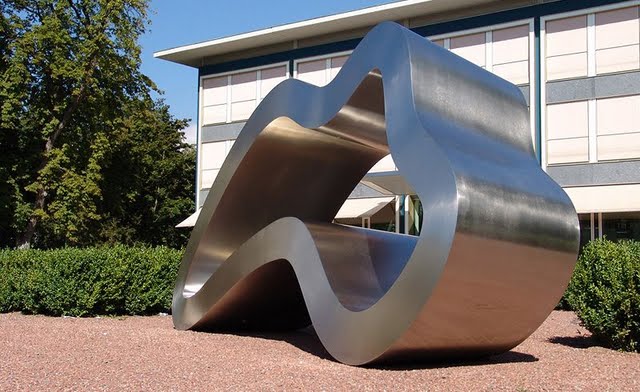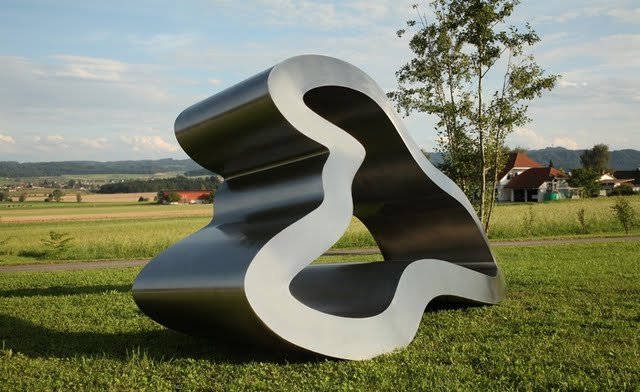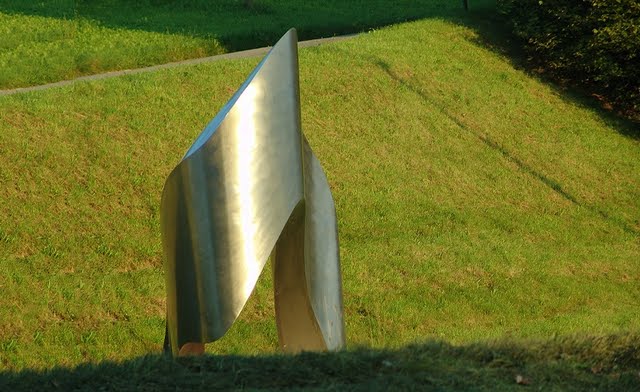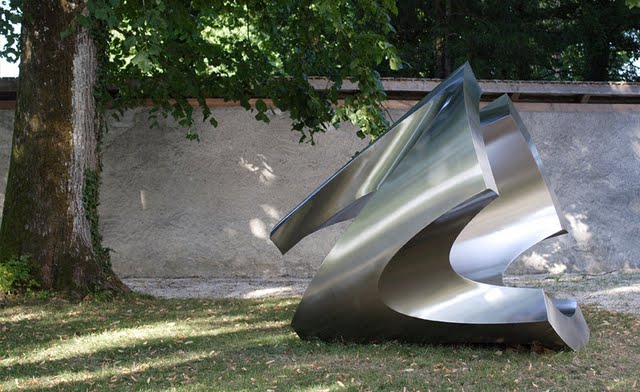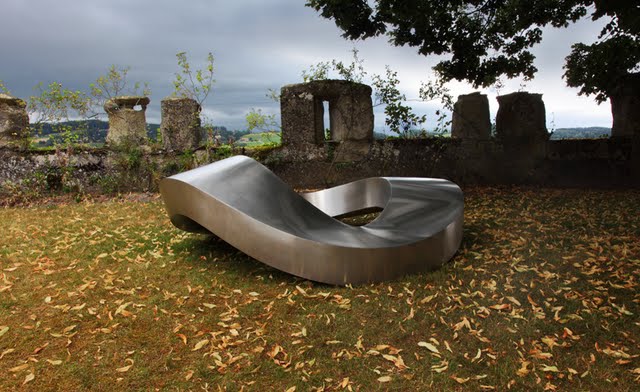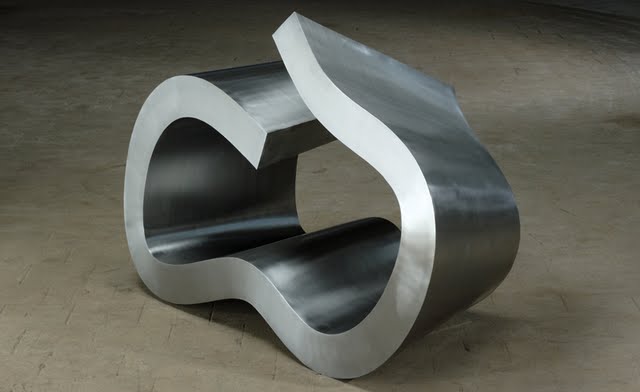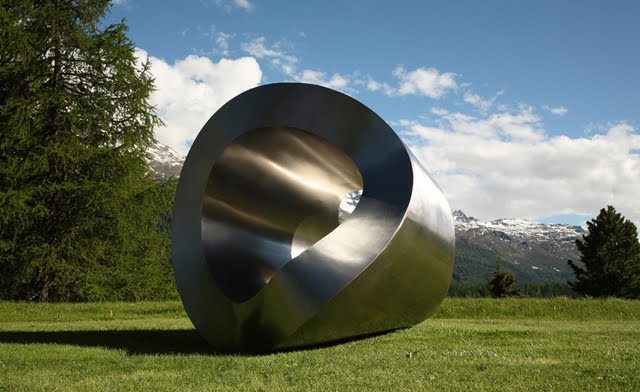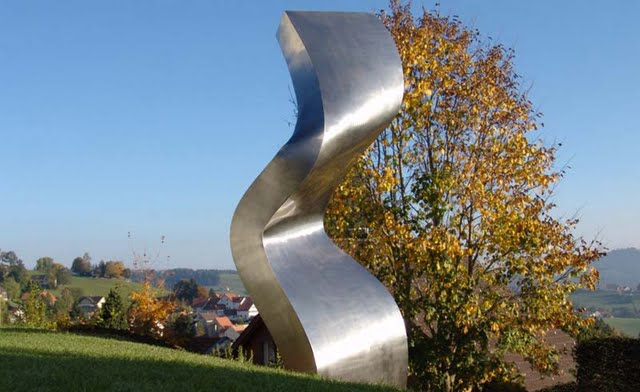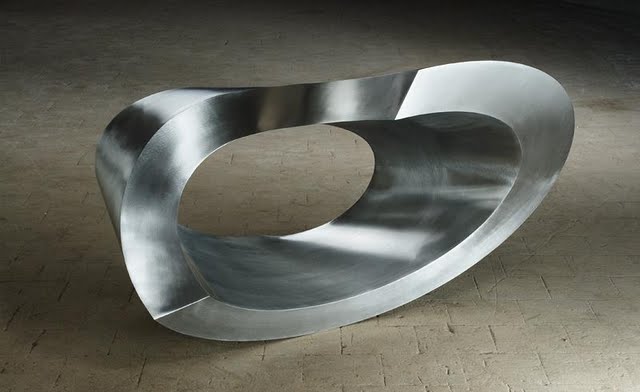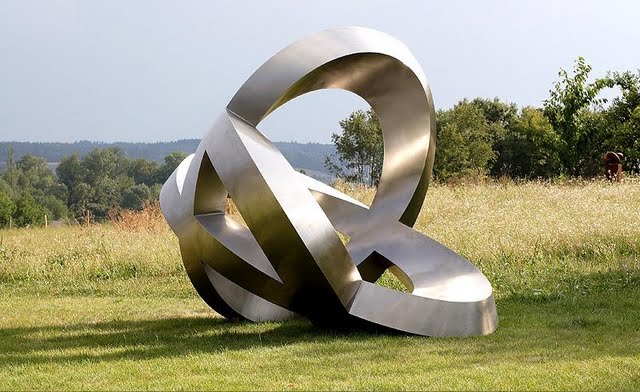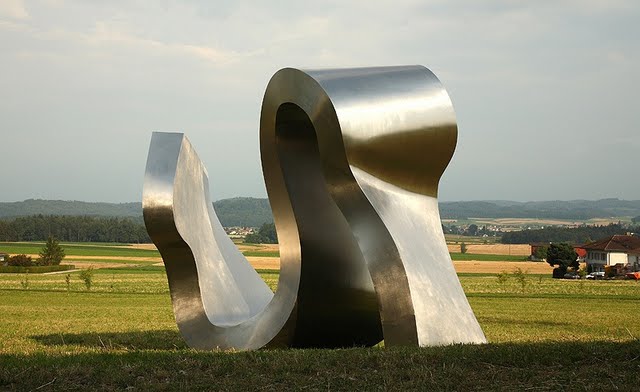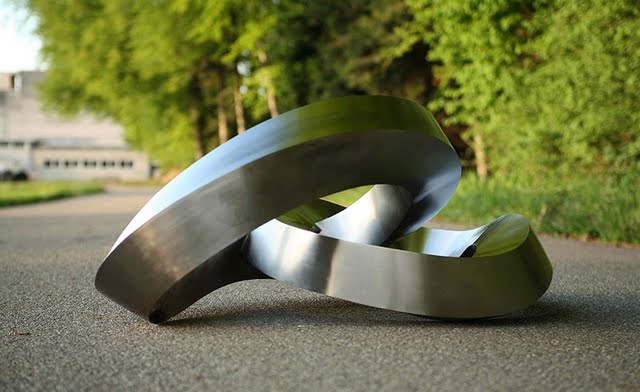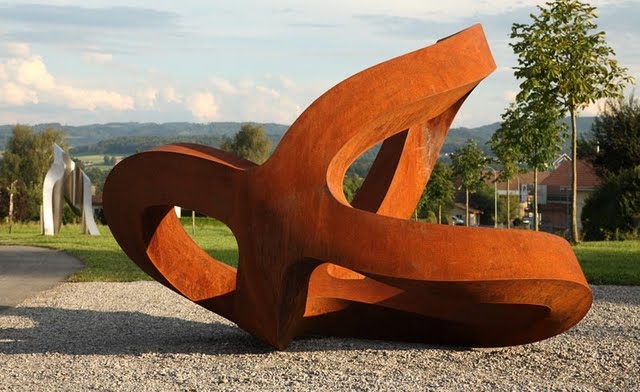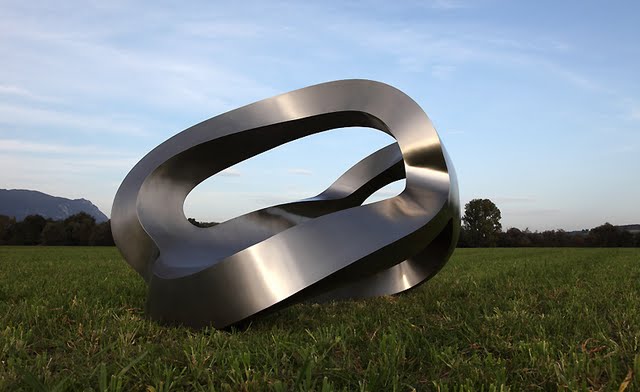Carlo Borer Biography

Swiss designer and sculptor Carlo Borer works entirely in three dimensions, from the development of objects in virtual space using CAD to the precise craftsmanship with which he creates his sculptures in the real world. Utilizing a variety of materials, especially steel and stainless steel, he carries forward the use of high-tech tools such as lasers throughout his creative process to produce objects that are concrete yet unearthly, curvilinear yet not quite organic. Many of his works are left untitled, so as not to provide any predetermined associations, leaving the interpretation of the forms open to the viewer’s imagination, perception, and interaction with the objects.
Born in 1961 in Solothurn, Switzerland, self-taught, and with no formal art school training, Borer has worked as a fine artist and industrial designer since 1981. In 2008, he won the Kanton of Solothurn, Switzerland Prize for Sculpture, and has exhibited his work in both Europe and the United States.
The recent steel sculptures by the Swiss artist Carlo Borer stand in the landscape, or in exhibition spaces, like messengers from another reality. Their strangeness is not overbearing, but the longer you look at them the more you surmise that their forms stubbornly deny comparison. Despite their rounded contours these works do not make an organic impression in the sense of biomorphic natural growth – for this, the curves change direction too abruptly, the lines are too unpredictable, the cuts and angles between the individual surfaces are not functional enough. The peculiar geometry of these structures of gleaming chrome steel or, lately, of rusted steel, stands somewhere unclassified between the poles of natural charm and technoid construction. Many of these sculptures circle around themselves, some form a system of closed rings or loops that intersect at different points. Their formally closed nature also makes them seem hermetically sealed in an emotional way, neither understandable by pure reason nor intuitively approachable. Borer acknowledges that some of his works have a certain “psychedelic quality” due to this irresolvable strangeness. Since with the exception of a very few works, Borer leaves his sculptures untitled, he foregoes determining their effect or guiding the viewer’s imagination in a certain direction. The real reason for the confusing formal quality of his sculptures lies in their origins in virtual space. Their forms are thus, neither oriented to natural models nor do they result from the confrontation with the tradition of abstract sculpture. Likewise, they do not arise from dealing with steel as a material or the methods of working with it. For Carlo Borer form defines itself primarily from possibilities presented by computer technology. With a few exceptions he develops all of his sculptures with the aid of special CAD (Computer-Aided-Design) programs.
Unlike traditional sculpture, Borer’s works do not depart from closed volume and compact mass. Instead, lines and surfaces in space are the essential creative elements of his works. Surfaces turning in on themselves and hard edges form a stark contrast within their forms. In this respect, the artist deals with two basic creative variations. The first is drawing freely in space, whereby each line always refers to a second track. In this way surfaces come about that move through space in open or closed surfaces (the so-called two guide sweep surfaces), which are later imbued with plastic volume. Often these are works moving as waves or loops. Sometimes they are incomplete “rolled-up” surfaces, perforated at times with numerous openings. The “two guide sweep surfaces” distinguish themselves in that each point of one line is connected by a straight line to a respective point on a corresponding second line. In this way the individual surfaces of the spatial structures may be calculated and “unwound”, i.e. they may thus be projected onto two dimensions in a way that the individual surfaces by be cut out of a sheet of steel using a laser. The complete sculpture is then assembled from these individual forms. This also applies to the second basic possibility of inventing forms at the computer. In this instance, however, Borer takes a defined geometric solid as a point of departure and cuts segments out of it using negative geometric forms. For the most part, the initial forms – which Borer also refers to as “mother forms” – are cones or blunt cones which may be rotated symmetrically.
Long before he developed his first sculptures constructed with the help of computer programs in 1998, Borer had been fascinated by the particular aesthetics of rotation forms. First he tried them out on colored objects made of polyester, later it was aluminum sculptures he used in playing through the symmetry of rotation. What interests the artist about rotating forms is an aesthetically effective moment a viewer can scarcely escape from, namely its potential dynamics. Despite their actual immobility the sculptural rotation forms inevitably create in the viewer an imaginary notion of a slow, or racing, rotary motion around a central axis. Borer’s earlier works have often been studded with rivets or even spikes, giving the sculptures a combative, highly energetic, if not aggressive, character. We associate with them the notion of huge spinning-tops, flywheels, cogwheels, and other machine parts. The cones and blunt cones are of special significance among the rotating bodies because their “perspective” narrowing lends them an additional dynamic element, an impulse towards the tip. The first sculpture Borer made of steel sheeting for public spaces in 1991 on the basis of a cone measures 6 meters in diameter and reminds us of an missile that has been partially rammed into the ground, a stranded spaceship, or an archaeological find from a heavy industrial epoch of a world that no longer exists, and whose meaning we are unable to grasp. The imagined motion of the sculptures is a continuing motif for Carlo Borer. Even with his extremely rare cubic forms, such as in the series “Sinking Cities” (1997), imaginary movement plays an important role, as the cuboid, diagonally cut forms seem to sink into the wall or the floor. It indicates that even the most stable positions are insecure and changeable.
The special formal quality of the blunt cone continues to interest Carlo Borer in his new works as well. It is one of the elementary characteristics of his art, a lasting formal obsession. But we need to look at these sculptures very closely from all sides in order to realize that their pseudo-organic round forms are actually based on blunt cones. These have been cut so radically, however, that it is the linear structures which dominate visually, pushing the geometric form that he used as a starting point into the background. Carlo Borer shows interest over and over again in such ambivalences between the construction principles and the perception of his works. During a conversation the artist reminded me that the experience of ambivalences corresponds precisely to the way we perceive and understand the world. Using rational models we are able to understand a lot, exploring further areas of knowledge from there. But at the same time, both in science and in our everyday dealings with things, we are wholly aware of the fact that we never have the complete truth, but rather only our ideas and notions which have been adapted to and shaped by our experience. Inevitably there remains in our knowledge an undeterminably large rest of things we cannot understand. Precisely what is left over is what Borer takes as theme in his art, or at least he tries to point to this. For him the task of art is to lend visible expression to the unknown, that is to say, to the inscrutable experience of the world that does not fit in our conceptual framework. Due to this ambivalence of practical experience and incomprehensibility, it is essential to Borer’s artistic concept that his works always allow us to recognize a high level of craftsmanship and technical effort without any recognizable purpose – including any figurative readability or symbolization of them. (We must think here of Immanuel Kant’s famous definition of beauty as “purposiveness without a purpose”). Out of this purpose-free craftsman-type precision and the opposition between the clearly structured form of the work and the lack of any functional designation as well as any genesis of the form that could be derived from experience, there arises the special aesthetic effect, the fascinating and confusing strangeness of Borer’s works.
For the artist the development of forms in the virtual space of the computer is anything but a mere end in itself. He is not concerned with exploring the characteristics of virtual spaces – quite the contrary. The computer is merely an implement affording possibilities which would never have been achievable with other tools. What is decisive is the transfer of these designs into a sensual, material reality that we may experience. This process may be compared to translating from one language to another. It makes possible a new type of description and definition of sculptural forms that we may sensually experience. Herein lies Borer’s challenge as an artist and craftsman: to transfer a purely mathematical definition of forms into concrete material existence, for this is where two completely different types of existence clash in a three-dimensional structure, something which cannot take place without friction and contradictions. (Actually there are even three stages of existence here: First the virtual design is transferred to the two-dimensionality of the steel sheets and only then is it transferred into real space). This translation work demands a high degree of expertise in the craft, experience with the material, care, and precision. All the while one needs the ingenuity it takes to solve unexpected difficulties that arise when transferring the virtual into real space. The assembly and welding of the laser-cut steel sheets into complex three-dimensional objects and the subsequent surface treatment are extremely labor intensive and call for the help of two assistants. Designing the works and carrying them out with perfect craftsmanship are of equal importance to the artist. Borer’s fascination with the technical realization of daring, unusually complex designs becomes clear, for example, when we learn that for several years he dealt with the production of spherically-shaped coffee machines made of stainless steel. He was not merely the designer who developed and constructed the machine for some company, but rather he manufactured a great number of these machines himself in an arduous development and production process.
Just as sculpture cannot exist only as a virtual construction, neither can it be viewed as mere abstraction. Carlo Borer’s works are sculptures of experience and as such, they refer to space and the concrete spatial situation of the viewer. They are fundamentally multi-perspective and must be approached visually from all possible angles by walking around them. We may only properly experience their complicated geometry if we follow their outlines and if we have grasped the interplay between material forms and perspectives as well as the changing relationships between the forms with their unexpected curves and angles. This is why Borer only very rarely works in small formats, since these allow for an overview and, to some extent, a “precipitous” grasp of the forms. It is absolutely vital to him that the sculptures remain in reference to human proportions, that they are large enough to potentially harbor the body of the viewer inside or to cover him up, but that they are never so oversized that we feel rejected or dominated by them. In this connection, it is remarkable that several of his newer works have been carried out in two versions, each different in appearance: in shiny chrome steel, which always has the tendency to stand out optically against the ambient space or even, as an ideal, virtual form, to elude us; and in rusted steel, with a much more “down-to-earth” effect due to its
warmer color and the irregularities in the patina of the rust and which – especially in outside nature – blends itself much easier into the environment.
In addition to his steel sculptures there is yet a small number of works among Carlo Borer’s oeuvres that he groups under the ironic title “Noreadymades”. These works differ greatly concerning material and appearance but they all share a common feature: They are composed of materials the artist has randomly found, which he has inserted into a new context especially constructed for them. The process entails integrating used and worn-out materials into an overall form in such a way that it looks like the entire sculpture is merely a ready-made, a detail that has been detached from a greater functional connection. The theme of “purposiveness without a purpose” is carried to an extreme in these works. We see the concept of the “Noreadymades” most clearly in the “Shampoos” of 2006. The three steel cones have been densely studded with blue plastic fibers of the kind we know from carwashes. From their worn ends, we can tell they have been used. The variously formed attachments to the circular bases of the highly-polished objects suggest a technical function: They make the sculptures seem like tools that could be placed into a larger machine. To an extraordinary degree, these works reckon with the viewer’s imagination. We cannot help but try to imagine a possible practical use, for example that the cones turn round and round as cleaning instruments. The truth is, however, that this is a pure construct. The plastic fiber threads do come from a carwash, but they are meticulously inserted in the stainless-steel cones especially made for this work and not at all pieces that were found. Each sculpture has around 2000 boreholes to hold the fiber threads. The linchpin forms that look like they should be attached to a giant machine are completely purpose-free mock-ups. The surface of the metal, polished to a sheen, anyway stands in contrast to the triviality of the worn- out plastic material, reducing the customary logic of the ready-made to absurdity.
Entirely similar, albeit using completely different material, is the way the untitled ensemble of 2005 functions (also in three parts). This ensemble consists of a combination of wood and copper. The hollow blunt cones that seem rather rustic have been made of wooden slats, which reveal traces of heavy use, and are held together at the ends and in the middle by a type of barrel hoop. The inner surface of the hollow body is covered with shimmering copper sheeting so that one is then again tempted to consider the sculptures as found objects and imagine their possible use. The coarse execution of the wooden frame with the highly visible “noses” and drip traces of the intentionally carelessly applied glue cause us to rather think of an agrarian context, such as tools of wine production. But here again this is a false lead: The barrel construction was made of old wood pallets, the copper sheets subsequently mounted with the utmost of care. Aesthetically the objects rely, for the most part, on the contrast of the materials, the warm, immaterial, shimmering light of the copper in the inside of the aesthetically modest wooden structure. It is easy to make diverse associations by means of this contrast, even to the point of imagery of the dualism of body and mind. Borer himself refers to the “platonic character” of the copper, which “runs through the object like an idea”. This remark may easily be applied to Borer’s entire production: His concern is always to show what happens when a formal idea takes on visible and sensual form.
2011
ArtHamptons, Evan Lurie Gallery, Bridgehampton, NY
Art Chicago, Evan Lurie Gallery, Chicago, IL
Chur, Kulturforum, Wurth
2010
Herpen,NL, ARTITLED Contemporary Art Zu¨rich, Art Station
Luzern-Emmenbru¨cke, AB Gallery Art Karlsruhe, One Artist Show, BEGE Galerien Ulm Ulm / DE, Fischerplatz Galerie, “2structures“ Ulm / DE, Galerie im Venet Haus, „2structures“
2009
Aarwangen, Kunstgarten, „Die Verwandlung“
2007
Jegenstorf, „When Fiction Becomes Evidence“ Stiftung Rotonda
Solothurn, Fixed to Torsion, Haus der Kunst, mit Franco Mu¨ller
2005
Gebenstorf, “All lies about gravity”, Galerie Krafft und Partner
2004
Solothurn The Big Loop, Ku¨nstlerhaus S11 & Amthausplatz Ero¨ffnung mit multimedia Happening Mitwirkende: Heinrich Breiter, Michel Mast, Stotter Inst, Everest
2000
Solothurn, Freitags Galerie „ Frozen Cities „ Zu¨rich, Galerie Ruth Allemann
1999
Biel, Kongresshaus
1997
Los Angeles,USA: Boritzer, Gray, Hamano Gallery, “Sinking Cities”
1995
Zu¨rich: Galerie Ruth Allemann, „Rotation Bodies“, Aluminium-Objekte
Los Angeles/USA: Boritzer, Gray, Hamano-Gallery
Bern: Galerie V. Mu¨ller
Burgdorf: DLG-B Dienstleistungsgeba¨ude Buchmatt in Zusammenhang mit der Galerie W Ursula Wittmer, Chromstahlobjekte
1994
Wangen a.A.: Galerie W Ursula Wittmer, „Rotationen“, mit Heinrich Breiter
Zuchwil: „Etienne Lois“, Installation, mit Heinricht Breiter
1993
Olten: Galerie Zeta
1992
Basel: Galerie Tobias Loeffel
Ittigen BE: Galerie im Talgutzentrum
1991
Grenchen: Contempo Galerie Zu¨rich: Galerie Ruth Allemann
1990
Solothurn: Kunstmuseum (Kantonales Kuratorium fu¨r Kulturfo¨rderung)
„Werkjahrbeitra¨ge des Kantons Solothurn 1989“, mit Rolf Blaser
1989
Oensingen: Schachen-Galerie
1988
Bern: Galerie Loeb
1985
Solothurn: Castel Burio Produktion
1983
Solothurn: Galerie Weber
Bern: Galerie Schifflaube
1981
Solothurn: Freitagsgalerie

